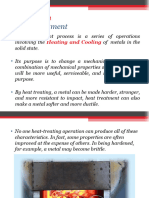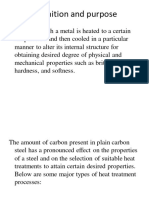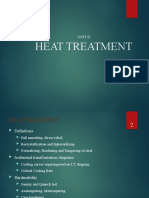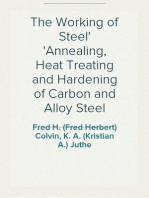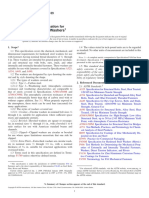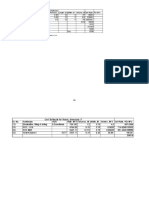0 ratings0% found this document useful (0 votes)
3 viewsReport 3
Report 3
Uploaded by
rondenacristina23Material Science and Engineering
Copyright:
© All Rights Reserved
Available Formats
Download as PPTX, PDF, TXT or read online from Scribd
Report 3
Report 3
Uploaded by
rondenacristina230 ratings0% found this document useful (0 votes)
3 views14 pagesMaterial Science and Engineering
Copyright
© © All Rights Reserved
Available Formats
PPTX, PDF, TXT or read online from Scribd
Share this document
Did you find this document useful?
Is this content inappropriate?
Material Science and Engineering
Copyright:
© All Rights Reserved
Available Formats
Download as PPTX, PDF, TXT or read online from Scribd
Download as pptx, pdf, or txt
0 ratings0% found this document useful (0 votes)
3 views14 pagesReport 3
Report 3
Uploaded by
rondenacristina23Material Science and Engineering
Copyright:
© All Rights Reserved
Available Formats
Download as PPTX, PDF, TXT or read online from Scribd
Download as pptx, pdf, or txt
You are on page 1of 14
HEAT TREATMENT
- Heat Treatment process is a series of operations
involving the Heating and Cooling of meals in the solid
state.
- Its purpose is to change a mechanical properties so
that the metal will be more useful, servicable, and safe
for definite purpose.
- By heat treatment, a metal can be made harder,
stronger, and more resistant to impact, heat treatment
can also make a metal softer and more doctile.
TYPES OF HEAT TREATMENT
1. Annealing
2. Normalizing
3. Quenching 0r Hardening
4. Tempering
5. Surface Hardening
6. Austempering
7. Marquenching
8. Ausforming
TYPES OF HEAT TREATMENT
1. Annealing
- It is the process for softening materials or to bring about
required changes in properties, such as machinability,
mechanical or electrical properties, or dimensional stability.
- The annealing process consists of heating the steel to or
near the critical temperature (temperature at which
crystalline phase change occurs) to make it suitable for
fabrication.
- A material can be annealed by heating it to a specific
temperature and the letting the material slowly cool to
room temperature in an oven.
- When an annealed part is allowed to cool in the furnace, it
is called a “full anneal” heat treatment.
TYPES OF HEAT TREATMENT
2. Normalizing
- It is a type of heat treatment applicable to ferrous metals
only.
- It differs from annealing in that the metal is heated to a
higher temperature and then removed from the furnace for
air cooling.
- The purpose of normalizing is to remove the internal
stresses induced by heat treating, welding, casting, forging,
or machining.
- Normaliziing is used in some plate mills, in the production
of large forgings such as railroad wheels and axles, some
bar products. This process is less expensive than annealing.
TYPES OF HEAT TREATMENT
3. Quenching or Hardening
- It is done to increase the strength and wear properties.
One of the pre-requisites for hardening is sufficient carbon
-and
To alloy content.
harden by quenching, a metal (usually steel or cast
iron) must be heated into the austentic crystal phase and
then quickly cooled.
- Depending on the alloy and other considerations, cooling
may be done with forved air or other gas, oil, polymer
dissolved in water, or brine.
- One drawback os using this method by itself is that the
metal becomes brittle. This treatment is typically followed
by a tempering process ro stress relieve the material and
minimize the brittleness problem.
TYPES OF HEAT TREATMENT
4. Tempering
- Tempering is carried out by preheating previously
quenched or normalized steel to a temperature below the
critical range, holding, and then cooling to obtain the
desired mechanical
- Tempering is usedparts.
to reduce the brittleness of quenched
steel.
- The temperature chosen for the tempering proces directly
impacts the hardness of the work piece. The higher the
temperature in the tempering process, the lower the
hardness.
TYPES OF HEAT TREATMENT
5. Surface Hardening
- It is the treatment of steel by heat or mechanical means
to increase the hardness of the outer surface while the core
remains relatively soft.
- Surface-hardened steel is also valued for its low and
superior flexibility in manufacturing.
- The oldest surface-hardenig method is carbunizing, in
which steel is placed at a high temperature for several
hours in a carbonaceous environment. The carbon diffusses
into the surface of the steel, rendering it harder.
TYPES OF HEAT TREATMENT
6. Austempering
- It is a treatment that is applied to ferrous metals, most
notably steel and ductile iron.
- In steel, it produces a bainiter microstructure whereas in
cast iron, it produces a structure of acicular ferrite and high
carbon, stabilized austenite known as austeferrite.
- It is primary used to improve mechanical properties or
reduce / eliminate distortion.
TYPES OF HEAT TREATMENT
7. Marquenching
- To overcome the restrictions of conventional quenching
and tempering, marquenching can be used.
- Martempering or marquenching permits the
transformation of Austenite to Martensite to take place at
the same time throughout the structure of the metal part.
- Residual stresses deveolped during marquenching are
lower than those developed during conventional quenching.
- Marquenching also reduces or eliminates susceptability to
cracking.
- Another advantage of marquenching in molten salts is the
control of surface carburizing or decarburizing.
TYPES OF HEAT TREATMENT
8. Ausforming
- Ausforming, also known as LOW AND HIGH
THERMOMECHANICAL TREATMENTS is a method used to
increase teh hardness and stunornness of an alloy by
simultaneously tempering, rapid cooling, deforming, and
quenching to change its shape and refine the
microstructure.
THANK YOU!
SHORT QUIZ
1. It is a heat treatment that is applied to ferrous metals, most
notably steel and ductile iron.
2. It is a series of operations involving the Heating and Cooling
of meals in the solid state.
3. What do you call when an annealed part is allowed to cool in
the furnace?
4. It is the process for softening materials or to bring about
required changes in properties, such as machinability,
mechanical or electrical properties, or dimensional stability.
5. What is the drawback of quenching or hardening process?
6. It is a treatment that is applied to ferrous metals, most
notably steel and ductile iron.
SHORT QUIZ
7. What is the other term of Ausforming?
8. It is a method used to increase teh hardness and
stunornness of an alloy by simultaneously tempering, rapid
cooling, deforming, and quenching to change its shape and
refine the microstructure.
9. This process permits the transformation of Austenite to
Martensite to take place at the same time throughout the
structure of the metal part.
10.It is the treatment of steel by heat or mechanical means to
increase the hardness of the outer surface while the core
remains relatively soft.
ANSWER KEY
1. Austempering
2. Heat Treatment
3. Full Anneal
4. Annealing
5. The metal becomes brittle.
6. Austempering
7. LOW AND HIGH THERMOMECHANICAL TREATMENTS
8. Ausforming
9. Marquenching
10.Surface Hardening
You might also like
- 12-SAMSS-021 General Purpose FencingDocument7 pages12-SAMSS-021 General Purpose FencingAbdul Nazir - 11858 Hawiyah Branch - QCNo ratings yet
- Comparison Astm and JisDocument4 pagesComparison Astm and JisGokulAgNo ratings yet
- Welding Inspection: Multi-Choice Questions Paper 4 Please Return This Paper UnmarkedDocument4 pagesWelding Inspection: Multi-Choice Questions Paper 4 Please Return This Paper Unmarkedmaani7zero0% (1)
- Report 3Document15 pagesReport 3rondenacristina23No ratings yet
- Amt 611 Heat TreatmentDocument44 pagesAmt 611 Heat TreatmentJhalbert Belmonte100% (1)
- Heat Treatment ProcessesDocument4 pagesHeat Treatment ProcessesMuhammad Zohaib Ali50% (2)
- Heat TreatmentDocument21 pagesHeat Treatmentarafiyo1850No ratings yet
- Heat Treatment Wps Office 1Document7 pagesHeat Treatment Wps Office 1shilohwilson30No ratings yet
- Objectives of Heat TreatmentDocument6 pagesObjectives of Heat TreatmentAdaitaChowdhury100% (1)
- Lesson 6 HeatTreatmentDocument7 pagesLesson 6 HeatTreatmentupenderNo ratings yet
- Mt14 ReviewerDocument16 pagesMt14 ReviewerMichelle TuballaNo ratings yet
- Heat Treatment of MetalsDocument20 pagesHeat Treatment of MetalsMuhammad AhmedNo ratings yet
- Heat Treatment 2Document56 pagesHeat Treatment 2qmkulimNo ratings yet
- Heat Treatment of MetalsDocument20 pagesHeat Treatment of MetalsNosheenKhurrumNo ratings yet
- Matreial Lab PDFDocument14 pagesMatreial Lab PDFNedaa AbboushiNo ratings yet
- Matreial Lab: Dr. Morad EtierDocument14 pagesMatreial Lab: Dr. Morad EtierNedaa AbboushiNo ratings yet
- Importance of Heat TreatmentDocument5 pagesImportance of Heat TreatmentArgha DasNo ratings yet
- What Is Heat Treatment?: Written By: Johnsinit - Edited By: Lamar Stonecypher - Updated: 1/8/2011Document2 pagesWhat Is Heat Treatment?: Written By: Johnsinit - Edited By: Lamar Stonecypher - Updated: 1/8/2011విష్ణువర్ధన్రెడ్డిNo ratings yet
- Unit 2: Heat Treatment of Iron and SteelsDocument24 pagesUnit 2: Heat Treatment of Iron and SteelsRahul kumarNo ratings yet
- HeattreatmentDocument29 pagesHeattreatmentUJJWAL PRAKASHNo ratings yet
- Heat Treatment of MetalsDocument14 pagesHeat Treatment of MetalsDawood AbdullahNo ratings yet
- 2B Heat Treatment Student NotesDocument8 pages2B Heat Treatment Student NotesASHISH SHARMANo ratings yet
- Heat TreatmentDocument30 pagesHeat TreatmentDr-Bharath Vedashantha Murthy100% (1)
- Heat Treatments PDFDocument2 pagesHeat Treatments PDFJhony BhatNo ratings yet
- Heat TreatmentDocument6 pagesHeat TreatmentHarsh SahuNo ratings yet
- Annealing, Normalizing, Quenching, Martensitic TransformationDocument22 pagesAnnealing, Normalizing, Quenching, Martensitic TransformationAboo BackerNo ratings yet
- Lec. 15 Heat TreatmentDocument4 pagesLec. 15 Heat Treatmentjfrm9480No ratings yet
- Amp Lecture NotesDocument98 pagesAmp Lecture NotesRadhika AmmuluNo ratings yet
- Heat Treatment of Plain Carbon SteelDocument12 pagesHeat Treatment of Plain Carbon Steelweda walata heduwaNo ratings yet
- Annealing, Normalizing, Quenching, Martensitic TransformationDocument22 pagesAnnealing, Normalizing, Quenching, Martensitic TransformationAboo Backer100% (1)
- Heat Treatment PDFDocument4 pagesHeat Treatment PDFKarthi KeyanNo ratings yet
- Thermal Processing of Metals & AlloysDocument10 pagesThermal Processing of Metals & AlloysOyedotun Tunde0% (1)
- 11 Heat Treatment ProcessesDocument38 pages11 Heat Treatment ProcessesKamal SurenNo ratings yet
- Heat Treatment ProcessDocument15 pagesHeat Treatment ProcessAd Man GeTig100% (1)
- J.W Material Notes MetallurgyDocument25 pagesJ.W Material Notes Metallurgyjosphat wambuaNo ratings yet
- Mechanical Engineering Fundamentals: Ali RazaDocument18 pagesMechanical Engineering Fundamentals: Ali RazaAhmad ButtNo ratings yet
- Heat Treatment of Metals and AlloysDocument4 pagesHeat Treatment of Metals and AlloysMuhammad Kashif KalyarNo ratings yet
- Heat TreatmentDocument8 pagesHeat TreatmentBaizura Mohd ZanNo ratings yet
- Heat Treatment ProcessDocument31 pagesHeat Treatment ProcessAbhishek IndalkarNo ratings yet
- Heat Treatment of MetalsDocument7 pagesHeat Treatment of MetalsGian BanaresNo ratings yet
- Question 3Document4 pagesQuestion 3Fazerin ShahNo ratings yet
- HeattreatmentDocument22 pagesHeattreatmentAtif AttiqueNo ratings yet
- Heat TreatmentDocument21 pagesHeat TreatmentChernet MerknehNo ratings yet
- Annealing (Metallurgy) : Merged DiscussDocument5 pagesAnnealing (Metallurgy) : Merged DiscussDia Andrita RahmanNo ratings yet
- Heat TreatmentDocument4 pagesHeat TreatmentPUBLIC USERNo ratings yet
- What Is Heat TreatmentDocument5 pagesWhat Is Heat TreatmentAbdulbar kelilNo ratings yet
- Heat Treatment FinalDocument7 pagesHeat Treatment FinalShu CedricNo ratings yet
- CHAPTER - Heat Treatment 3rd Sem ManufacturingDocument11 pagesCHAPTER - Heat Treatment 3rd Sem Manufacturingkaranragav12No ratings yet
- Heat TreatmentDocument14 pagesHeat TreatmentsonawanepmsNo ratings yet
- Heat Treatment 1Document21 pagesHeat Treatment 1jayesshsk66No ratings yet
- Heat Treatment 2Document12 pagesHeat Treatment 2Nataraj Mohan100% (1)
- Unit 2 Heat TreatmentDocument59 pagesUnit 2 Heat TreatmentAmutha PSGRKCWNo ratings yet
- AUE515 PPT Module 3Document16 pagesAUE515 PPT Module 3nnamanianthony3No ratings yet
- Lecture-6: Heat Treatment of Metals and Alloys - Importance Heat Treatment Processes NormalisingDocument47 pagesLecture-6: Heat Treatment of Metals and Alloys - Importance Heat Treatment Processes NormalisingSarojKumarSinghNo ratings yet
- Lecture 5 - Heat Treatment, Forging and Casting (Autosaved) (Auto-Saved)Document64 pagesLecture 5 - Heat Treatment, Forging and Casting (Autosaved) (Auto-Saved)charmaineNo ratings yet
- MSM - UNIT-5 (8)Document21 pagesMSM - UNIT-5 (8)yaswanth.katta9996No ratings yet
- Heat Treatment ServisDocument10 pagesHeat Treatment ServisMuhammad SyameerNo ratings yet
- Heat TreatmentDocument33 pagesHeat TreatmentIsrael HailuNo ratings yet
- The Working of Steel: Annealing, Heat Treating and Hardening of Carbon and Alloy SteelFrom EverandThe Working of Steel: Annealing, Heat Treating and Hardening of Carbon and Alloy SteelNo ratings yet
- Oxy-Acetylene Welding and Cutting: Electric, Forge and Thermit Welding together with related methods and materials used in metal working and the oxygen process for removal of carbonFrom EverandOxy-Acetylene Welding and Cutting: Electric, Forge and Thermit Welding together with related methods and materials used in metal working and the oxygen process for removal of carbonRating: 4 out of 5 stars4/5 (1)
- The Working of Steel Annealing, Heat Treating and Hardening of Carbon and Alloy SteelFrom EverandThe Working of Steel Annealing, Heat Treating and Hardening of Carbon and Alloy SteelRating: 5 out of 5 stars5/5 (4)
- Layout 2 of 7Document1 pageLayout 2 of 7rondenacristina23No ratings yet
- Layout 1 of 7Document1 pageLayout 1 of 7rondenacristina23No ratings yet
- Chapter 2 - Jhazel ReportDocument26 pagesChapter 2 - Jhazel Reportrondenacristina23No ratings yet
- FINAL COMPONENTS AND SPECIFICATIONSDocument9 pagesFINAL COMPONENTS AND SPECIFICATIONSrondenacristina23No ratings yet
- Lighting Layout - Mm-Layout1Document1 pageLighting Layout - Mm-Layout1rondenacristina23No ratings yet
- 2nd ReportDocument5 pages2nd Reportrondenacristina23No ratings yet
- Transmission LinesDocument10 pagesTransmission Linesrondenacristina23No ratings yet
- Influence of Nonmetallic Inclusion Characteristics OnDocument10 pagesInfluence of Nonmetallic Inclusion Characteristics OnEngels OchoaNo ratings yet
- Schedule of Rates '2014 - Water Supply WorksDocument49 pagesSchedule of Rates '2014 - Water Supply WorksanshdivyNo ratings yet
- Connectors ProcessDocument4 pagesConnectors ProcessÎĺ ÝéšNo ratings yet
- Notes:: 6"-12" PIPE Flowline Removable AnchorDocument1 pageNotes:: 6"-12" PIPE Flowline Removable Anchornarutothunderjet216No ratings yet
- Welding SymbolsDocument9 pagesWelding Symbolsjojo_323100% (3)
- Grades of Bolts PDFDocument2 pagesGrades of Bolts PDFVCNo ratings yet
- Trulaser 3030 / 3040: Technical DataDocument3 pagesTrulaser 3030 / 3040: Technical DataaNKURNo ratings yet
- Jis G4105Document2 pagesJis G4105walitedisonNo ratings yet
- For Construction: MAX. DIST. 0.5EDocument1 pageFor Construction: MAX. DIST. 0.5EHimal Nilanka RathnayakaNo ratings yet
- Resistance WeldingDocument18 pagesResistance WeldingAnand JainNo ratings yet
- CaseHard AISI8620Document2 pagesCaseHard AISI8620Anonymous B3I6zYNhqdNo ratings yet
- Hardened Steel Washers: Standard Specification ForDocument6 pagesHardened Steel Washers: Standard Specification ForjayNo ratings yet
- Make A Wheel Marking GaugeDocument6 pagesMake A Wheel Marking Gaugeserkan ünlü100% (1)
- CH 05 PDFDocument11 pagesCH 05 PDF朱亦詳No ratings yet
- MXR Phase 90 Script Pedal ModDocument14 pagesMXR Phase 90 Script Pedal ModInfoMecanicaTaller contactoNo ratings yet
- Attachment-8 - Approved Vendor List - Signed Thai OilDocument29 pagesAttachment-8 - Approved Vendor List - Signed Thai OilNikhil VermaNo ratings yet
- Miginox 347 / Tiginox 347: Classification: ApprovalsDocument1 pageMiginox 347 / Tiginox 347: Classification: ApprovalsJagannath SahuNo ratings yet
- 08 Hoisting WinchingDocument35 pages08 Hoisting WinchingAndrés RiosNo ratings yet
- Magnesium Alloys in Ingot Form For Sand Castings, Permanent Mold Castings, and Die CastingsDocument4 pagesMagnesium Alloys in Ingot Form For Sand Castings, Permanent Mold Castings, and Die CastingsDhavalNo ratings yet
- Material Equivalent STD PDFDocument1 pageMaterial Equivalent STD PDFANIL100% (1)
- COE-110.06, Corrosion FailuresDocument90 pagesCOE-110.06, Corrosion Failuresامين100% (1)
- D&D Basic Adventure (1st Level) - The Forge of RogbrokDocument17 pagesD&D Basic Adventure (1st Level) - The Forge of RogbrokKeshav MondalNo ratings yet
- Cost AnalysisDocument13 pagesCost Analysisnaveen yadavNo ratings yet
- European Standard Norme Européenne Europäische NormDocument35 pagesEuropean Standard Norme Européenne Europäische NormVitor MachadoNo ratings yet
- ASTM A 513-08A - Electric Resistance Welded Carbon and Alloy Steel Mechanical Tubing - Standard SpecsDocument17 pagesASTM A 513-08A - Electric Resistance Welded Carbon and Alloy Steel Mechanical Tubing - Standard SpecsPhúc ChâuNo ratings yet
- Presentation Serial Defects FullDocument5 pagesPresentation Serial Defects FullssdinspectionltdNo ratings yet
- 4 Metal Cutting PDFDocument42 pages4 Metal Cutting PDFaviraj2006No ratings yet







